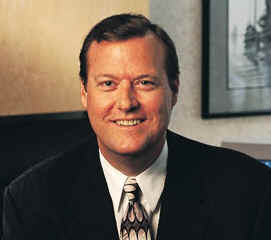|
|
Assisted Living Concepts Inc. (ASLC) |
|
|
CEOCFO
Interview Index |
This is a printer friendly page! Assisted
Living Concepts is offering America’s seniors assistance with daily living, such as
clinical services, housekeeping, laundry service, three meals a day and life-enrichment
activities for only eighty dollars a day BIO: Mr. Vick: “Assisted Living Concepts has changed dramatically since I came in February of 2002. We are focusing on the clinical aspect of providing high acuity services so that our residents can age in the residences instead of moving prematurely to institutional services. We can do this by charging them appropriately for the high acuity services, and providing customer service with respect to the aging process. The company has been profitable for seven quarters in a row. The company in the previous eight years had never been profitable. The second quarter of 2004 was the most profitable quarter in the history of the company in terms of revenue and in terms of profitability.” CEOCFOinterviews: You mentioned charging appropriately for services, will you elaborate? Mr. Vick: “Assisted Living Concepts is the first company that went public as a pure-play assisted living company in 1994 and the founder of the company is based in Oregon. We were one of the five that originally went public. We were the original pilot program for the state of Oregon in a progressive reimbursement program that Oregon invented with the founder of this company to fund assisted living as a meaningful alternative from a financial and life-enhancement alternative to people that traditionally go to nursing homes inappropriately. Oregon was the first state that created that model. This company went public with that development focus. They were based upon a social model of meeting the needs of the residents but not from a Wall Street profitability; it was more of a Ben and Jerry’s social model, and then Wall Street got after it and funded over fifteen billion dollars in the subsequent four to five years. When I came, there were certain markets that were twenty to twenty-five percent undercharging for the services we were providing, and we were providing inconsistent services. The list was great for taking care of people that we were inappropriately taking because of the lack of training and lack of services. We evaluated the competition and we said that quality care is going to cost money and the consumer is going to pay for that when they become educated about it, and when they look at institutional care that they are going to have to move into or have home health take care of them. It is the highest cost to stay in your own home or provide that skilled care or intermittent care that you would get from us at a reasonable cost of sixty to eighty dollars a day.” CEOCFOinterviews: Charging appropriately is very meaningful to you is that correct? Mr. Vick: “Exactly! Sixty dollars a day is where we were five years ago and now we are at about seventy-five or eighty dollars a day and you can’t stay at a nice branded hotel and get breakfast throughout the United States for that. We are giving clinical services, housekeeping, laundry service, three meals a day and life-enrichment activities and all of those things for eighty bucks a day.” CEOCFOinterviews: How do you keep personnel costs down while employing responsible and competent caregivers? Mr. Vick: “We have a competitive advantage. We are in small towns and the development strategy here was to develop these 177 buildings in towns of about 10,000 to 40,000 people. We are not operating in downtown Detroit or downtown Chicago. The clientele of the employee base know the residents. The caregivers are coming to us because they want to make a difference and they want to add value to a senior person’s life. We are seeing that passion side of the employee wanting to stay here and add value. We have a competitive advantage because in a small community, our average house has forty apartments and our average employee base is about five or six people in the house at one time from an employee standpoint. They get to know the resident, are an active, meaningful participant in that person’s life and they are driven just like we are. In the pursuits that accountants or engineers do, these people want to do that. When they go to a nursing home to work and they get specialized on just feeding people or just doing housekeeping, they don’t get that same sense of fulfillment. They come to our house and they have forty customers and they are an intricate part of their lives and they want to do a variety of jobs, such as a little bit of housekeeping, a little bit of food, a little bit of life enrichment and it is tremendously rewarding for them.” CEOCFOinterviews: What is your occupancy rate? Mr. Vick: “Our occupancy was about 82% when I came twenty-four months ago and now it is over 90%. It would be higher than that but we have almost two dozen buildings in the state of Indiana that were previously never licensed to provide assisted living and they are in the process of getting those licenses. The state of Indiana from our occupancy is at 71%. We got the first two buildings licensed and we are looking forward to getting them all licensed by the end of this year. We are looking forward to higher occupancy and we continue to work on it every day.” CEOCFOinterviews: What are you doing to change stereotypical impressions of assisted living and nursing homes? Mr. Vick: “With
respect to assisted living, I think that as long as providers are vigilant and deliver the
promises they make to consumers, then the government is going to be satisfied with the way
we are policing and monitoring our business. Back in the sixties when Joseph Califano and
President Johnson created the Medicare and Medicaid program and nursing homes were
institutionally created, the government said this is the way you are going to have your
hallways and your windows and your rooms, and we are going to pay for it the government
became the customer. That is why all nursing homes are identical. CEOCFOinterviews: Going forward, do you see changes for assisted living such as new services or areas of focus? Mr. Vick: “I don’t think that the assisted living community exists of what it could be. It is only recently that people understand what assisted living is. It is now in the yellow pages under its own title. Hillary Clinton and senators are saying that assisted living is a patchwork of state regulations. It is rather fuzzy out there of what this assisted living means. I think it is up to us as providers to say specifically what it is and to deliver on the promises that we make so that you see the difference between the Hilton Hotel, the Marriott Hotel, and the like, and for the consumer to benefit from that. Otherwise, you are going to see the federal government get involved and it is going to go the way of nursing homes and that is my concern. That is what we as a provider group and our associations are trying to police ourselves to keep the government out and keep it at a state level because all of our buildings, with exception to Indiana, are licensed and surveyed by a third party. I think that is a meaningful government process for the states and the consumers of that state to have and to be guided by.” CEOCFOinterviews: Do you have specialty systems? Mr. Vick: “We don’t; it is purely assisted living. Our average unit is about forty apartments, which are all single-story. As you might know, over the age of 65, one out of four people suffer from some kind of memory care or dementia and need those services. We are looking forward to expanding into memory care specifically and adding on fourteen to twenty units so that we can complement the community with Alzheimer-specific care and also provide those services to our residents and leverage our internal fixed costs. We look forward to doing that next year.” CEOCFOinterviews: How big a part of your budget is the physical maintenance of the buildings and what is your program in making sure that they are up to expectations on a continual basis? Mr. Vick: “Because we went public in the end of 1994 and started the construction phase in 1995-1997, our buildings are all less than eight years old. We enjoy a relatively new environment and we are dedicated to continue to maintain those. However, our maintenance is not a significant amount.” CEOCFOinterviews: In closing, why should potential investors be interested and what should they know that they don’t see when they look at your material? Mr. Vick: “The company went through bankruptcy in the fall of 2001. When I came in the first quarter of 2002, we focused on the customer, appropriate billing and profitability and managing that margin with a mission; and subsequently we became profitable. After the bankruptcy, however, there were four or five major investors who ended up with eighty percent of the company. In the fall of 2002, there was an additional investor who bought ten percent. As we sit today, we have five or six investors owning ninety percent and we are traded over the counter. In May, the board announced publicly its hiring of Jefferies & Company Inc. to explore strategic alternatives, which would include selling the company. We see a tremendous need for this kind of product and we see the management and the ability to leverage the infrastructure that we have and the opportunity to expand. We are going through the process with Jefferies now of trying to figure our how we can expand our shareholder base and either strategic options. If people want to buy a piece of the company over the counter, with the little float that we have, the small volumes are affecting the price substantially. That is not fair for anyone, nor is it necessarily reflective of the value of the company. We are expecting to conclude this process in the next ninety to a hundred and eighty days.” disclaimers |
|
To view Releases highlight & left click on the company name!
|
|





